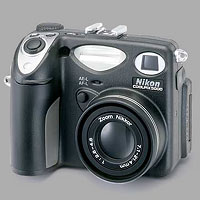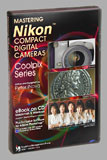|
Jump back to Breaking News... Note: The CP5000 has the dynamic range and color clarity of the 995 along with the per-pixel detail of the 990. That makes for some mighty good eatin'. Here's how to get more on your plate than you may have thought.
|
So many images are shot with a dynamic range outside the realm of photographic reality, that somebody ought to do something about it. Okay. I hear you. What if you could raise the photon-consciousness of certain shadow details of an image without blowing out the mid-tones or highlights?, I asked me. Oddly enough, the inner dialogue produced some answers.  Here is an image that clearly has two primary tonal regimes. The highlights are about as bright as one could expect them to be before bleaching out utterly. The sky behind that guitar, for instance, is 100% luminance with only a whiff of blue in it. But those poor people down below. They look like they would have trouble reading a road map in that dim light. But wait a minute. Now I remember. This isn't what it looked like to my eye at all! Those folks were quite well lit. How come they look so muddy in the shot? Remember that eyes have a 30,000:1 typical dynamic range at any given light adaptation. Making those people look many stops brighter to my casual gaze. But the dynamic range of the CP5K and virtually all digital imaging devices is about 500:1 tops. Meaning the camera has about 1.6% of the range of my eye. Those folks would look dim on a slide exposed for the sky. But since this is digital photography, the dynamics of the image are up for grabs. So let's grab the shadows and pull them up:  Now that's more like it. A lot more of the way my eyes remembered the scene. A new new iNovaFX Filter set iShadowLift.atn will premiere on Version 4.0 of the Mastering Nikon™ Compact Digital Cameras eBook when it debuts in February, 2002. As usual, owners can upgrade for a fraction of the cost of a new eBook. Variations for 3-megapixel and 5-megapixel images will be in the set, along with several strengths for greater or lesser effect, and even a ShadowLift2Taste version you can tune to your preference (used for this shot in its default setting). No, it's not for every image by a long shot. Some images don't work with the principles it uses. Will it work for your shot? There's only one way to know. Try it. The iShadowLift.atn file will ONLY be on the V4.0 disk. Check the Upgrade Order Page for availability. All Upgrade disks ordered from January 26, 2002, onward will receive a free V4.0 disk when it becomes available, and... All eBooks ordered from January 26, 2002, onward will receive the update disk for free, as well, when it appears. Check the Breaking News stories for the announcement that heralds Version 4.0. How it came to be: The Coolpix 5000 inspired a new capability. Nice things happen when the pixel count goes up. The noise of the image goes down on prints. Why? Because all that detail is getting smaller and smaller. You could have an image that a two-megapixel camera would show as downright grainy but on a 5-megapixel camera it won't look nearly as gritty. How come? The 5-megapixel image is 250% the size of the 2-megapixel image. Or, in other words, that grain is now only 40% of the size it was in the smaller camera. Heavy Lifting That means certain operations which might introduce too much sandpaper into the image for small imagers could now be used without calling attention to tonal artifacts. Thus it is with heavy lifting of shadow detail. In essence, brightening shadows is much like giving them a higher ISO while leaving the ISO of brighter parts of the picture alone. Push processing is what we used to call it in film, and like digital images, film got grainier the harder you pushed. So these new iNovaFX Filters lift the ISO of the low end of the shot without touching into the highlights. At least that's the theory. It works for shots that seem to have two distinct areas of interest --highlight and shadow-- and it helps for your original image to have the shadow detail seen best in the CP995 and CP5000. Meaning well-defined in tonal separation and color.
Or you can call direct and order from the publisher by phone or FAX.
© 2002 Peter iNova. All rights reserved. Do not reprint. Simply add a link to this page. |
 Shadows got you down?
This iNovaFX Filter picks them up.
Shadows got you down?
This iNovaFX Filter picks them up. Get the eBook
Get the eBook